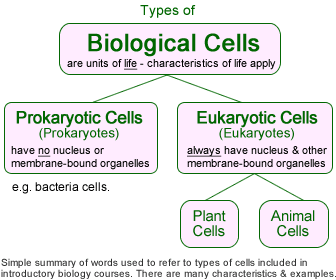Plant, Animal and Bacterial Cells
Biological cells are the basic units of life i.e. the smallest units that can be alive.
There are many types of biological cells.
Classification of Biological Cells:
Biological taxonomy is the identification and naming of species and the arrangement of them into biological classes (i.e. groups). A taxonomic rank is a level in a taxonomic hierarchy, of which 'kingdom' is one of the highest ranks - its exact position in the taxonomic hierarchy depends on the system used. The Five-Kingdom system of biological classification proposed by Robert Whittaker in 1969 is based mainly on differences in nutrition and groups life forms:
Life |
Empire Prokaryota |

|
Kingdom Monera (prokaryotes, i.e. bacteria & "blue-green algae") |
 includes Bacterial Cells includes Bacterial Cells
|
 |
Empire Eukaryota |

|
Kingdom Protista (single-celled eukaryotes) |
|
Kingdom Plantae (plants) |
 includes Plant Cells includes Plant Cells
|
Kingdom Fungi (fungi) |
|
Kingdom Animalia (animals incl. humans) |
 includes Animal Cells includes Animal Cells
|
|
|
Above: The Five-Kingdom System of Biological Classification
Some school biology courses e.g. UK A-Level (AS and A2) include the structures of:
The biggest difference between these is that unlike eukaryotic cells, prokaryotic cells do not have a cell nucleus or any membrane-bound organelles such as mitochondria. Instead, all of the contents of the cell is openly accessible within the same volume e.g. ribosomes are scattered throughout the cytoplasm (not attached to the surfaces of the endoplasmic reticulum as in animal cells).
This table compares key features in plant, animal and bacterial cells:
|
Cell Feature: |
Plant Cells |
Animal Cells |
Bacteria Cells
(Prokaryotic cells) |
1. |
Cell Wall |
Plant cell walls are made mainly of cellulose. |
none |
Prokaryotic cell walls are made of murein. |
2. |
Cell Nucleus |
Controls the activity of the cell and contains the genetic material. Each cell nucleus is surrounded by a double nuclear membrane that is crossed by nuclear pores. |
Controls cell activity and contains the genetic material. The largest cellular organelle in animal cells, surrounded by a double nuclear membrane crossed by nuclear pores. Most animal cells have one nucleus, but: |
none |
- Some very large cells (e.g. some striated muscle fibres) have many nuclei. Such multinucleate cells are called coenocytes.
- Some special cells (e.g. erythrocytes) have no nucleus. Cells that have no nucleus are called anucleated cells.
|
3. |
Plasmids |
none |
none |
A plasmid is a molecule of DNA that is separate from and can replicate independently of the chromosomal DNA. They are double-stranded, generally circular, and capable of replicating autonomously within a suitable host. |
|
4. |
Mitochondria (pl.)
the singular form is "mitochondrion" |
Mitochondria provide the cells' energy requirements. In the same way as cell nuclei they have a double membrane. The outer membrane of a mitochondrion is smooth while the inner membrane forms folds called cristae to increase the inner membrane's surface area on which sugar combines with oxygen to produce ATP - the cell's primary energy source. |
none |
5. |
Ribosomes |
The ribosomes present in plant and animal cells are the larger (80 S) type of ribosomes but are the smallest and most numerous of the eukaryotic cell organelles. They are composed of protein and RNA and are the sites of protein synthesis.
Ribosomes can exist free in the cytoplasm but are usually found attached to rough endoplasmic reticulum (RER). The ribosomes in eukaryotic cells are made in the nucleolus - which is inside the cell's nucleus. |
Ribosomes are present - but are very small. That is, the ribosomes in prokaryotic cells (i.e. bacterial cells) are the smaller (70 S) type. |
6. |
Chloroplasts |
Chloroplasts are green (because they contain the pigment chlorophyll) and are members of a class of organelles called plastids. They capture light energy, store it in the molecules ATP and NADPH, then use it to produce organic molecules and free oxygen from carbon dioxide and water by the process of photosynthesis. |
none |
none |
7. |
Permanent vacuole |
Contains water needed for turgor pressure (turgidity) - that pushes the plasma membrane, which is also called the cell membrane, against the cell wall. Plants need turgidity to maintain rigidity. Molecules and ions may also be stored in the permanent vacuole. |
none |
none |
 |
 |
 |
 |
 |
|
|
Note: The numbers on the left are just for ease of reference to this table re. plant, animal and bacteria cells. The above is not a detailed comparison of these different types of biological cells but includes key differences in their contents at approx. the level of detail required for A-Level Biology.
See also prokaryotic cell structure, animal cell structure, plant cell structure and an introduction to cell division.











